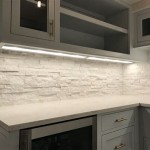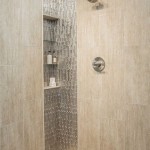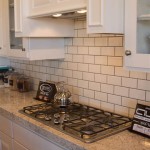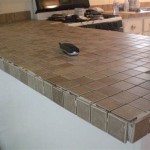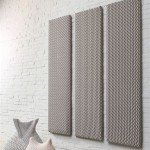Beautifying Your Kitchen With A Small Subway Tile Backsplash
The kitchen backsplash serves as a crucial element in both the aesthetic appeal and functional design of any kitchen. Beyond its primary role of protecting walls from spills and splatters, the backsplash presents an opportunity to introduce texture, color, and pattern into the cooking space. Among the myriad of backsplash options available, the small subway tile backsplash stands out as a versatile and timeless choice. Its classic rectangular shape, typically measuring 3x6 inches, offers a clean and understated elegance that can be adapted to suit a wide range of kitchen styles, from traditional to contemporary.
The popularity of the small subway tile backsplash stems from its adaptability and inherent design qualities. Its smaller size, compared to larger format tiles, allows for greater flexibility in layout and pattern, enabling homeowners to create unique and personalized designs. Furthermore, the relatively low cost of subway tile makes it an accessible option for budget-conscious renovations. Whether arranging the tiles in a classic horizontal stack bond pattern, a more modern vertical layout, or a creative herringbone design, the small subway tile backsplash provides a foundation for creating a visually appealing and functional kitchen space.
The Enduring Appeal of Small Subway Tiles
Subway tiles originated in the early 20th century, first appearing in the New York City subway system. Their glossy, easy-to-clean surface and uniform size made them an ideal choice for a high-traffic environment. The clean, functional aesthetic of these tiles quickly gained popularity, extending beyond the subway and into homes and businesses. This enduring appeal can be attributed to several factors:
Timeless Design: The simple rectangular shape and clean lines of subway tiles contribute to a timeless aesthetic that transcends trends. This allows the backsplash to remain stylish for years to come, without appearing dated. Unlike trend-driven designs that may quickly fall out of favor, the subway tile backsplash offers a classic and enduring appeal.
Versatility: Subway tiles are incredibly versatile and can be incorporated into a variety of kitchen styles, from traditional farmhouse to modern minimalist. The ability to customize the grout color, tile material, and layout pattern allows homeowners to tailor the backsplash to their specific design preferences. This adaptability makes subway tiles a suitable choice for almost any kitchen renovation project.
Ease of Maintenance: The smooth, non-porous surface of most subway tiles makes them easy to clean and maintain. Spills and splatters can be quickly wiped away with a damp cloth, preventing staining and ensuring that the backsplash remains looking its best. This ease of maintenance is particularly important in the kitchen, where surfaces are frequently exposed to food and liquids.
Cost-Effectiveness: Compared to other backsplash materials, such as natural stone or glass tiles, subway tiles are generally more affordable. This makes them an accessible option for homeowners on a budget who are looking to update their kitchen without breaking the bank. The wide availability of subway tiles also contributes to their affordability.
Design Considerations for a Small Subway Tile Backsplash
While the small subway tile backsplash offers a wealth of design possibilities, careful planning is essential to achieve the desired aesthetic. Several factors should be considered when selecting and installing a subway tile backsplash, including tile material, grout color, layout pattern, and overall kitchen design.
Tile Material: Subway tiles are available in a variety of materials, including ceramic, porcelain, glass, and natural stone. Ceramic is the most common and affordable option, offering a wide range of colors and finishes. Porcelain is more durable and water-resistant than ceramic, making it a suitable choice for high-moisture areas. Glass tiles offer a sleek and modern look, while natural stone tiles provide a more rustic and textured appearance. The choice of tile material should be based on budget, aesthetic preferences, and functional requirements.
Grout Color: The grout color plays a significant role in the overall look of the backsplash. A contrasting grout color, such as dark gray or black, will accentuate the individual tiles and create a more graphic and dynamic effect. A matching grout color, such as white or cream, will create a more seamless and understated look. The grout color should be chosen to complement the tile color and the overall kitchen design. Consider the potential for staining with lighter grout colors in high-use areas.
Layout Pattern: The standard horizontal stack bond pattern is the most common and traditional layout for subway tiles. However, there are many other creative layout options to consider, such as vertical stack bond, herringbone, running bond, and basketweave. The layout pattern can significantly impact the overall look of the backsplash. A vertical layout can elongate the wall and create a sense of height, while a herringbone pattern adds visual interest and sophistication. Experimenting with different layout patterns can help achieve a unique and personalized look.
Overall Kitchen Design: The backsplash should complement the overall kitchen design, including the cabinetry, countertops, and flooring. Consider the color palette, style, and materials used throughout the kitchen when selecting the subway tile backsplash. A cohesive design will create a harmonious and visually appealing space. Ensure the backsplash complements, rather than clashes with, the existing elements of the kitchen.
Installation Tips for a Small Subway Tile Backsplash
While professional installation is often recommended, a small subway tile backsplash can be a manageable DIY project for homeowners with some experience in tiling. Proper preparation and attention to detail are essential to ensure a successful and long-lasting installation. Following these tips can help ensure a satisfactory outcome:
Surface Preparation: Ensure that the surface is clean, smooth, and level before beginning the installation. Remove any existing wallpaper, paint, or debris. Repair any cracks or imperfections in the wall using patching compound. Prime the surface with a tile primer to improve adhesion.
Layout Planning: Plan the layout of the tiles before applying any adhesive. Use a level and a measuring tape to mark the starting point and ensure that the tiles are aligned correctly. Avoid small slivers of tile at the edges of the backsplash by adjusting the layout as needed. This can be accomplished with careful measurements and adjustments to the starting point.
Adhesive Application: Apply a thin, even layer of tile adhesive to the wall using a notched trowel. The size of the notch will depend on the size and type of tile being used. Work in small sections to prevent the adhesive from drying out before the tiles are applied.
Tile Placement: Press each tile firmly into the adhesive, using a twisting motion to ensure good contact. Use tile spacers to maintain consistent grout lines. Remove any excess adhesive from the tile surface with a damp sponge.
Grouting: Allow the adhesive to dry completely before grouting the tiles. Remove the tile spacers and apply grout to the grout lines using a grout float. Work the grout into the lines, ensuring that they are completely filled. Remove any excess grout from the tile surface with a damp sponge. Allow the grout to dry according to the manufacturer's instructions, and then buff the tiles with a clean cloth to remove any haze.
Sealing: Seal the grout lines with a grout sealer to prevent staining and moisture damage. Apply the sealer according to the manufacturer's instructions. Regular cleaning and maintenance will help to keep the backsplash looking its best for years to come.
The small subway tile backsplash offers a timeless and versatile design solution for kitchens of all styles. Its enduring appeal, adaptability, and ease of maintenance make it a popular choice for homeowners looking to update their kitchen space. By carefully considering the tile material, grout color, layout pattern, and overall kitchen design, it is possible to create a visually appealing and functional backsplash that enhances the beauty and value of the home.

34 White Subway Tile Backsplash Timeless Classic

Creative Ideas For Kitchen Subway Tile Backsplashes
:strip_icc()/149227403_1128522247578130_6231868015445811908_n-8c71c052c7d843b69a24ecc60eb5c213.jpg?strip=all)
21 Subway Tile Backsplash Ideas

White Subway Tile Backsplash Ideas 2025 Guide

33 Subway Tile Backsplashes Stylish Ideas For Kitchens

34 White Subway Tile Backsplash Timeless Classic

23 Ways To Decorate With Subway Tile Architectural Digest
:max_bytes(150000):strip_icc()/1.102216971w-3cfce240962c441fbc9d5816e93cb70b.jpg?strip=all)
15 Kitchen Backsplash Ideas

13 Ways To Make A Subway Kitchen Backsplash Feel Fresh

White Subway Tile Backsplash Ideas 2025 Guide
Related Posts

